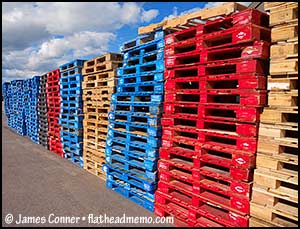23 February 2016
Retired educator makes heavy work of backcountry photography

Pallets, shot with 117g Nikon S3000.
On walks around town and country, and sometimes on hikes, when I want only the means to snap photographs that trigger memories, I carry a 117-gram digital camera the size of a credit card. With careful technique, meaning keeping my hands steady, I can record images that make good letter-sized prints.
Retired science teacher Lee Silliman, as reported in a wonderful story by the Missoulian’s Rob Chaney, uses battleship caliber equipment, a seven-kilogram 8x10 view camera (a beautifully constructed and maintained wood and brass Wisner), plus a heavy tripod, film holders, and ancillary equipment that probably increases his photograph load to at least 12 kilograms.
When I decide to take a photograph, I stop, stand still, steady my camera, and trip the shutter. It takes less than a minute. Sometimes I use a monopod or tripod and a bigger camera. That usually takes five minutes or so.
Silliman basically takes hours to set up his equipment and expose his black and white sheet film, which costs five dollars a sheet and is getting harder to find.
I enlarge my images, printing them as large as 13 x 44 inches on photo quality paper with an eight-color Epson pigment based printer. Silliman makes 8x10 contact prints.
I work with 21st century equipment and technique.
Silliman’s approach and equipment resembles that of the great 19th century photographers such as Timothy O’Sullivan, who lugged his 9x12 camera and portable processing laboratories into the wildest and remotest places in the nation.
Is my approach more valid than Silliman’s? No. Does my approach produce images with more artistic and technical merit than Silliman’s? No, of course not. In fact, historians probably will give him higher marks for artistry than they will give me.
But our differences do illustrate how advances in photographic science have affected how backcountry photograph is practiced.
A quick review of my equipment locker’s contents illustrates how much change has occurred.
When I hiked in Baja California in 1969, I carried a zone focusing Kodak 35mm camera with an f/3.5 anastigmatic lens, and shot Plus-X black-and-white film. A few years later, I moved up to a consumer grade Yashica rangefinder 35mm with an f/1.8 40mm lens, and shot Kodachrome and Agfachrome. After a few months shooting 2.25-inch film with a twin lens reflex, I bought a Pentax Spotmatic IIa with a 55mm f/1.7 lens, which I supplemented with 28mm and 100mm f/2.8 Fujinons.
In the mid-1980s, I switched to a Nikon FE2, first with a 28–105mm Vivitar Series 1 varifocal lens. I soon replaced the varifocal lens with a 24mm f/2.8 Sigma macro, a 55mm f/2.8 Micro Nikkor, and a 105mm f/2.5 Nikkor. Today, my 195-gram Nikon Coolpix P310 provides the same angles of view, outstanding micro performance, grainless images, and much better low light performance.
In 1997 I began my switch to digital, purchasing a small Kodak camera that produced 493-pixel-wide images with impressive multicolor shot noise. Two years later, I spent over $900 for a Nikon Coolpix 950 digital camera with 1,600 x 1,200 resolution. I still have the 950 because equipped with a Hoya R72 filter, it allows handheld infrared photography.
Since purchasing the 950, I’ve shot only a few rolls of films. I’ve acquired several digital cameras, from point-and-shoots to DSLRs — and basically, I’ve never looked back. I don’t miss working by dim safelight in a darkroom stinking of fixer. Nor do I miss the high price of film. Digital is much less expensive, produces richer and more accurate color, and provides instant feedback. And advances in image processing software make stitching individual photographs together into a panorama possible for the masses. Printing panoramas using analog techniques is a much more difficult task.
Working with lightweight digital cameras, I can make photographs in the backcountry at any time of day, and produce color and/or black-and-white versions of the same image. And with improvements in sensors and lenses, small format digital is closing the resolution gap with large format film.
I admire Silliman’s skill and dedication, and hope that a reputable institution, such as the University of Montana, will inherit his body of work after he expires. But I shudder at the thought of lugging heavy old time equipment across a studio — and panic at the thought of hauling it miles into the wilderness. I’ll stick with my P310, which yields very sharp and snappy 13x19 prints.
Silliman’s images are on display at Gallery 709 in Missoula. Be sure to see them while you can.
